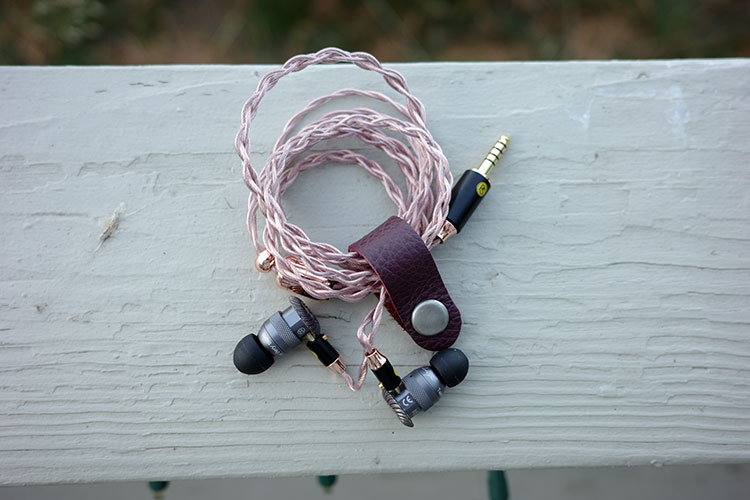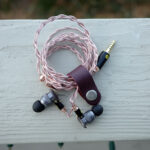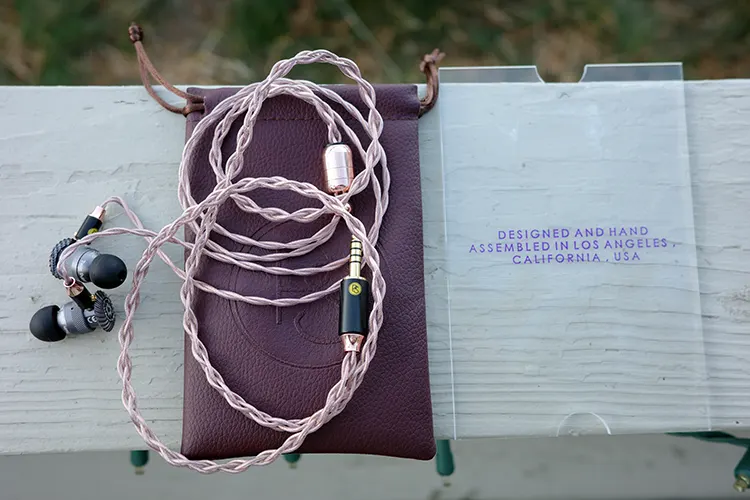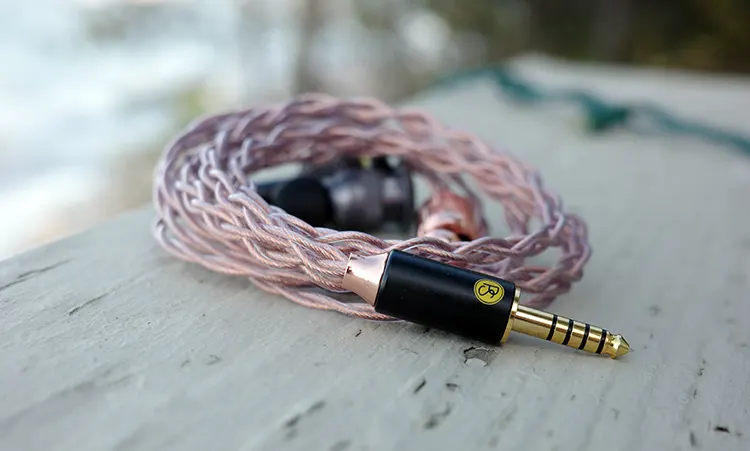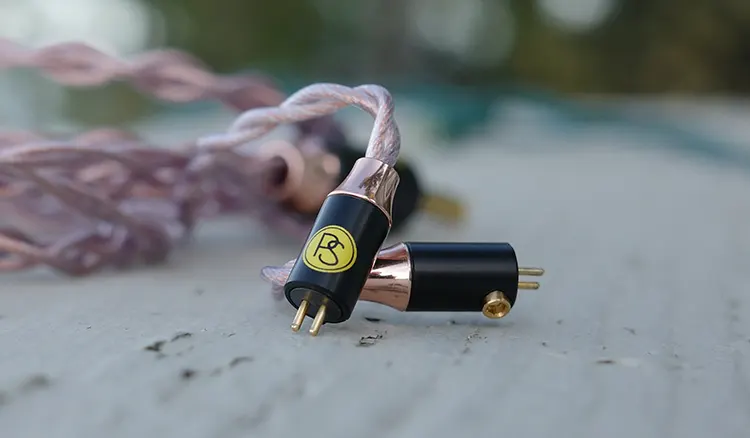In this feature, Lynn reviews the PLUSSOUND Dual Copper, which is a new 4-wire 26AWG-rated Litz copper and PPC audio cable priced from $499.
Disclaimer: This sample was sent to me in exchange for my honest opinion. Headfonics is an independent website with no affiliate links. I thank the team at PLUSSOUND for giving me this opportunity.
Click here to read more about PLUSSOUND products previously featured on Headfonics.
Note that this article follows our current scoring guidelines which you can read in more detail here.
PLUSSOUND has done plenty of work upgrading and enhancing its copper cable lineup in the last few years.
A good example of this was the Copper XL which I found provided all of the benefits of a copper-based cable performance, while also providing the most “un-copper-like” sound I have heard. The level of detail wrought from the cable rivaled silver-wire cables.
The new Dual Copper cable priced at $499 uses some of the same techniques and is copper-based while focusing more on a traditional copper sound. Warm yet engaging with detail, it is also the company’s most supple cable I have reviewed thus far.
Materials & Geometry
The Dual Copper wiring is a 26AWG mix of copper and palladium copper. A new “hybrid core” uses both wiring and dampening material, for increased conductivity, while reducing mechanical vibration, much like the Copper XL.
Unlike the Copper XL though, the Dual Copper is soft, pliable, and quite flexible. An enamel coating is added to each strand like the company flagships, adding to the flexibility when combining all of the above.
That hybrid core keeps both copper types wound tightly and more closely together, enhancing the circular shape. This also reduces mechanical vibration. It is PLUSSOUND’s propriety outer insulation that helps with the flexible, pliable feel.
Undergoing the same cryo treatment that aligns the crystal boundaries closer allows for faster transmission of electrical signatures. This also lowers distortion and electrical resistance, as well as microphonics; while providing the listener with a purported excellent signature.
Design
Similar to the other models in PLUSSOUND’s lineup, the dual Copper has a very high level of craftsmanship. The fit and feel are better than the Copper XL to me. This could be due to the thinner gauge wire as well as the softer, more supple feel to it.
Four 26AWG wires are wound together in a loose pattern making the wind somewhat loose. Those four wires are split into two strands for each side above the Rose Gold Y-splitter, with a Rose Gold cinch used to tighten the cable as needed.
One thing I like is that each strand of wiring in the Type 6 Litz design can be seen, wound tightly together using the company technique. Even with that, the soft supple design comes through.
While there is no sleeve around the ear loop, there is a sharp bend to the cable coming out of the 2-pin 0.78mm jack, which works quite well.
Finishing
PLUSSOUND offers many customization options for its cables including the plug type and color, splitter, cable ring, and connectors.
The Dual Copper cable sample I have here has a gold-plated 4.4mm balanced plug, with a larger rose gold-colored splitter that comes in the shape of a barrel, a rose gold cable ring, and yellow and black connectors, with rose gold sheaths. The PLUSSOUND logo is yellow instead of silver like the Copper XL.
The connectors used on the test cable are gold-plated, 2-pin, 0.78mm connectors however PLUSSOUND provides many other variations such as rhodium and MMCX connections among others.
A continuing feature of the Dual Copper and PLUSSOUND cables in general, is that the left and right-side indicators are shown by a small button that faces the outside of the connector. In the case of our sample, that button is gold-plated.
Handling
The Dual Copper cable is quite flexible, and supple, making it very comfortable to wear and no discomfort was noted during testing, not even from the bend around my ears. The smaller 26AWG played into that comfort, and I could listen for long sessions without bother.
With that smaller gauge size, I had no issues while wrapping the cable to fit into an IEM case, or when unwrapped.
This is one of the most comfortable cables I have in my possession, and a large part of that is the wrapping and lay of the strands. The cable lays well when unwrapped, with no stiction. No microphonics are heard, either.
There is a greater than 90-degree bend approximately ¾” from the rose gold sleeve, which acts as the ear hook and does a better job than the thicker PLUSSOUND offerings. This helps fit too, keeping the cable close to my ear, and out of the way with no chance of catching it on anything.
Packaging & Accessories
The PLUSSOUND Dual Copper continues the tradition of exemplary unboxing sessions, with items thought of as standard in the luxury bracket. The Dual Copper does not fail in that regard, much like previous models in the lineup.
The cable comes in the standard PLUSSOUND packaging which is a small rectangular box laden with the PLUSSOUND logo and additional lingo.
Inside the box, there is a rectangular clear plastic plate which, when lifted, reveals a purple leather pouch housing the Dual Copper cable. The pouch is also big enough to carry the cable connected to your favorite IEM.
Underneath this is a separate section with a purple leather cable tie (with a snap), warranty card, thank you note, PLUSSOUND sticker, and a cleaning cloth. The leather pouch and cable tie are of high quality while still soft and supple.
Performance Impressions
The following performance impressions were completed using the Copper XL paired with the Empire Ears Legend X and Spirit Torino Twin Plus Beryllium IEM.
Sources and amps included the Cayin N6ii and the HiBy FD5. I also tethered the HiBy R4 to the FD5, and both players were also connected to the FiiO K9 Pro ESS.
Summary
The PLUSSOUND Dual Copper adds a touch of richness and warmth, as one might expect from a copper cable, but not as much as the Copper XL, which makes sense.
There is a level of clarity, which seems to be the way copper cables are going, which is a far cry from the typical copper of days gone by, which added depth, warmth, and richness. I believe the palladium plays a part in this aspect.
The better-than-average clarity helped by placing instruments succinctly, while pairing with a tonality that showed through nicely but wasn’t too analytical.
There was enough clarity to make this cable competitive with others but falls short of the Copper XL. This tune falls more in line with a traditional copper cable, but with the additional details that make it a step above.
Timbre
Copper is known to add more color to a signature than silver, seemingly at the expense of detail. The palladium helps alleviate that trend in the Dual Copper.
The sub-bass and mid-bass ranges from my paired IEMs showed improved clarity (but less than a silver cable), while also reaching a bit deeper as expected.
The unique characteristics of the Dual Copper allow the warmth of a “typical” copper sound to show through, but that richness also pervades a sense of clarity that comes across as refreshingly detailed.
I am a fan of copper cables, especially ones that fit a rich, warmer character. However, the Dual Copper is such that this warming of sound also carries a lifting experience to the level of clarity that is distinctly different than the typical copper.
It is this lifting of detail retrieval that makes the Dual Copper more unique than the average copper.
This follows with sumptuously detailed mids, including female vocals that sound especially vibrant. The resolution is very good, with a bit less organic feel to the sound, which aligns with copper cables.
That lifting effect carries the upper region, giving plenty of space for the adequately weighted notes to fill the space. But those notes are heard distinctly and clearly, instead of melded together like many copper cables.
The preponderance of copper tendencies still lies within, but that slight decrease in note weight gives the sound a natural proclivity to carry forward the less-than-copper bent.
Mind you, there is still a smoothing character to the Dual Copper, but this smoothness in no way overshadows the character of succinctness of notes; which is a good thing.
Staging & Dynamics
Of near equal dimensions to me, the Dual Copper fills that space with a preponderance of tight, controlled note quality; filling the space in all dimensions.
The tight note quality did not overshadow the smooth character as noted and left me with a thoroughly engaging sense of musicality across many genres. The succinct notes allowed each layer to show forth with character, and excellent separating qualities, but not at the expense of melding the character.
While imaging was more centric, the delineation of layers allowed each to show their mettle, while combining to present a thoroughly engaging personality that filled that equal space. While detail retrieval might fall behind its higher kin, this did not detract from the musical experience in which I engaged.
Some cables excel in certain areas, leaving other aspects lacking by default. A typical copper cable comes across as warm and rich but can lack detail retrieval. The Dual Copper transcends that barrier affording the listener a full cubic effect, without becoming distracted by stuffiness or an overly bloated fit in that box.
Instead, the combination allows the fullness to show through in an equality that makes for that smooth, engaging textural character.
Synergy
The Dual Copper cable paired well with the two IEMs used. It may pair better with those looking to improve detail from their IEM without losing bass quality.
However, do not expect it to add much in the low end, like a typical copper cable. That said, there is an additional quality to the bass that belies what one expects from a copper cable.
Empire Ears Legend X
It is not a secret that the Legend X offers an overwhelming amount of bass. Recognized at the time as one of the very best down low, it can become ponderous to some.
While using the Dual Copper, I found that the best bass qualities of the LX were still present but tamed a bit without losing character.
The bass was not any lower, but became a bit tighter in control, with a less obvious bleed into the mids. Note definition became a bit better pronounced, without losing weight or attack and decay.
Where the Copper XL excels in sub-bass presentation, the Dual Copper aims higher, into the lower mids to give that added detail retrieval.
This works to not only allow less bleed into those mids but also carry forward the character of filling in the space mentioned above.
The filling in of the soundstage does not become cumbersome due to the ability to remain full in the note with the succinct but not overly short attack and decay.
Spirit Torino IEM Twin Pulse Beryllium
The Twin Pulse Beryllium has a naturally smooth signature, which can become a bit lighter using the included 4.4mm balanced cable. That organic sound carries over with the Dual Copper but with a level of detail matching the “stock” cable.
Bass also hits a bit tighter with the Dual Copper, and somewhat deeper in the mid-bass region. Control is the key here, with the ever-present midrange coming through with very good clarity.
This allows the Dual Copper to provide a bit different sound from the stock cable in as much as the PLUSSOUND affords the listener with detail above the stock cable and better control of the low-end.
The top end remains smooth with good reach, and no sibilance at all. The extension at the top makes higher-level instrumentations sing with a sweetness that the stock cable cannot quite match.

